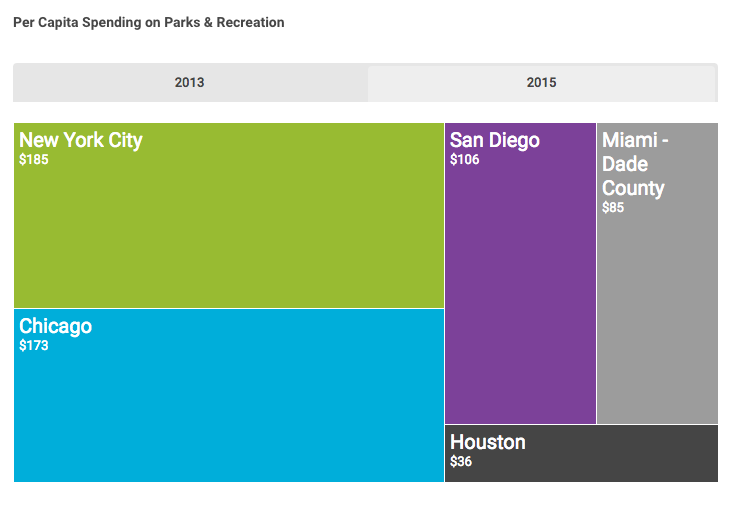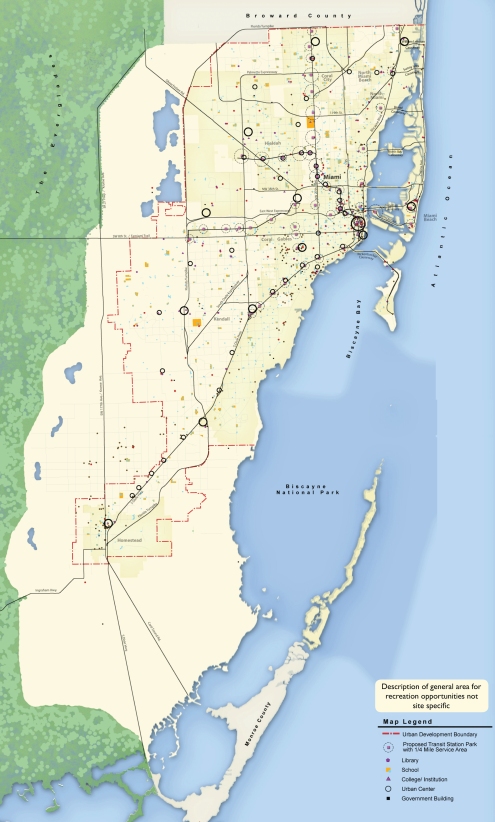Miami needs a commitment to parks.
What is the best park in Miami? The one that comes to mind is Bayfront Park, a park that has enjoyed a great deal of funding, public events, new proximity to museums and public transport. But just for a moment, think of Bayfront in comparison to the Common of Boston; Central Park or Prospect Park of New York; Millennium Park of Chicago; or Hyde Park of London. Miami insists on comparing itself to these cities of the world but fails to meet them on public amenities and planning.
In addition, Miami lags in total park space per capita. Hyperdense New York City has about 20% more, while Houston and San Diego have about 5 times as much (Miami Foundation). In a city that was densified by the Miami-21 Zoning code, proper open space offsets must be set aside to control planning and create a livable city.

Per capita spending on parks and recreation per city in 2015
I had the pleasure of recently hosting a “My Miami Story” conversation, and in my conversation with 10 Miami residents, every single person said that more money, resources, and space should be devoted to our parks. Cities like Houston, Dallas, Los Angeles, Kansas City, etc. are devoting resources to public space, and Miami needs a better plan for the future of its parks.
It may have started with Bayfront Park, but must spread to include neighborhoods like Kendall, Miami Shores, Little Havana, Hialeah, and South Dade. Parks help to define neighborhoods, foster community, increase after-school programming, and create public event space.
Miami has proposed a number of “systems-based” parks, that snake through the city such as the Underline and the Ludlam Trail. While these create great ways to connect our neighborhoods, they lack a space for things, events, moments to happen. For communities and neighborhoods to come together. For people to feel proud of their enclave of Miami.

Miami Open Space Master Plan
A plan to create a series of place-making parks in Miami’s diverse neighborhoods would help to add amenities and value to each, and perhaps density and mass transit may follow. Public amenities help to create communities worth living in; worth cleaning up; worth running for office to represent; and worth paying for. Maybe that can be a small catalyst to help us begin to think about how Miami can grow for all of us.




Love your blogs on Miami Grid. I think Miami Parks do need some major upliftment! While I do agree that none of the parks , including the Bayfront park do not compare to Central Park or Millenium park, but I must say, Kennedy park in grove and Bill Baggs park in Key Biscayne do have.a lot to offer.
LikeLike
Great post! Have you considered having discussions like on podcasts or making videos? Def should consider it dude!
LikeLike
More than anything Miami is screaming for the Metro train to be extended West to FIU campus and South to Homestead. No use having parks when you are sitting in traffic many hours a day. Parents dont have time to take kids to the park!
LikeLike
Public transit is a huge part of the future of our city as well! I will definitely be writing a post about that coming up.
LikeLike
kindly call me at 786-597-8067 asap re traffic congestion & proposed demolition of Hyatt Regency & courtyard Marriott in downtown Miami & One BayfrontMiami
LikeLike